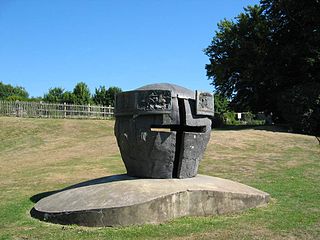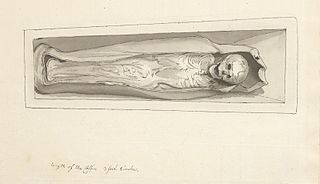Related Research Articles

Blood libel or ritual murder libel is an antisemitic canard which falsely accuses Jews of murdering Christians in order to use their blood in the performance of religious rituals. Echoing very old myths of secret cultic practices in many prehistoric societies, the claim, as it is leveled against Jews, was rarely attested to in antiquity. According to Tertullian, it originally emerged in late antiquity as an accusation made against members of the early Christian community of the Roman Empire. Once this accusation had been dismissed, it was revived a millennium later as a Christian slander against Jews in the medieval period. The first examples of medieval blood libel emerged in England in the mid 1100s before spreading into other parts of Europe, especially France and Germany. This libel, alongside those of well poisoning and host desecration, became a major theme of the persecution of Jews in Europe from that period down to modern times.

Year 1264 (MCCLXIV) was a leap year starting on Tuesday of the Julian calendar.

Joseph of Arimathea is a Biblical figure who assumed responsibility for the burial of Jesus after his crucifixion. Three of the four canonical Gospels identify him as a member of the Sanhedrin, while the Gospel of Matthew identifies him as a rich disciple of Jesus. The historical location of Arimathea is uncertain, although it has been identified with several towns. A number of stories about him developed during the Middle Ages.

Louis VIII, nicknamed The Lion, was King of France from 1223 to 1226. As a prince, he invaded England on 21 May 1216 and was excommunicated by a papal legate on 29 May 1216. On 2 June 1216, Louis was proclaimed "King of England" by rebellious barons in London, though never crowned. He soon seized half the English kingdom but was eventually defeated by the English. After the Treaty of Lambeth, he was paid 10,000 marks, pledged never to invade England again, and was absolved of his excommunication.

Hugh of Lincoln was an English boy whose death in Lincoln was falsely attributed to Jews. He is sometimes known as Little Saint Hugh or Little Sir Hugh to distinguish him from the adult saint, Hugh of Lincoln. The boy Hugh was not formally canonised, so "Little Saint Hugh" is a misnomer.

York Castle is a fortified complex in the city of York, England. It consists of a sequence of castles, prisons, law courts and other buildings, which were built over the last nine centuries on the south side of the River Foss. The now ruined keep of the medieval Norman castle is commonly referred to as Clifford's Tower. Built originally on the orders of William I to dominate the former Viking city of Jórvík, the castle suffered a tumultuous early history before developing into a major fortification with extensive water defences. After a major explosion in 1684 rendered the remaining military defences uninhabitable, York Castle continued to be used as a gaol and prison until 1929.

William of Norwich was an apprentice who lived in the English city of Norwich. He suffered a violent death during Easter 1144. The city's French-speaking Jewish community was blamed for his death, but the crime was never solved. William's case is the first known example of a medieval blood libel.

The history of the Jews in England goes back to the reign of William the Conqueror. Although it is likely that there had been some Jewish presence in the Roman period, there is no definitive evidence, and no reason to suppose that there was any community during Anglo-Saxon times. The first written record of Jewish settlement in England dates from 1070. The Jewish settlement continued until King Edward I's Edict of Expulsion in 1290.
In early modern Europe, particularly in Germany, a court Jew or court factor was a Jewish banker who handled the finances of, or lent money to, royalty and nobility. In return for their services, court Jews gained social privileges, including, in some cases, being granted noble status.

The first Jews in England arrived after the Norman Conquest of the country by William the Conqueror in 1066, and the first written record of Jewish settlement in England dates from 1070. Jews suffered massacres in 1189–90, and after a period of rising persecution, all Jews were expelled from England after the Edict of Expulsion in 1290.
Richard of Devizes, English chronicler, was a monk of St Swithin's house at Winchester.
History of European Jews in the Middle Ages covers Jewish history in Europe in the period from the 5th to the 15th century. During the course of this period, the Jewish population experienced a gradual diaspora shifting from their motherland of the Levant to Europe. These Jewish individuals settled primarily in the regions of Central Europe dominated by the Holy Roman Empire and Southern Europe dominated by various Iberian kingdoms. As with Christianity, the Middle Ages were a period in which Judaism became mostly overshadowed by Islam in the Middle East, and an increasingly influential part of the socio-cultural and intellectual landscape of Europe.

The Rhineland massacres, also known as the German Crusade of 1096 or Gzerot Tatnó, were a series of mass murders of Jews perpetrated by mobs of French and German Christians of the People's Crusade in the year 1096,. These massacres are often seen as the first in a sequence of antisemitic events in Europe which culminated in the Holocaust.

Aaron of Lincoln was an English Jewish financier. He is believed to have been the wealthiest man in Norman England; it is estimated that his wealth exceeded that of the King. He is first mentioned in the English pipe-roll of 1166 as creditor of King Henry II for sums amounting to £616 12s 8d in nine of the English counties. He conducted his business through agents, and sometimes in conjunction with Isaac, fil Joce; by these methods building up what was practically a great banking association that spread throughout England.
Aaron of York or Aaron fil Josce, was a Jewish financier and chief rabbi of England. He was born in York before 1190 and died after 1253. He was probably the son of Josce of York, the leading figure in the York pogrom of 1190.
Thomas Netter, OCarm was an English Scholastic theologian and controversialist. From his birthplace he is commonly called Thomas of Walden, or Thomas Waldensis.

Yom Tovof Joigny, also denoted of York was a French-born rabbi and liturgical poet of the medieval era who lived in York, and died in the massacre of the Jews of York in 1190. A Hebrew language hymn attributed to him, transliterated "Omnam Kayn" or "Omnam Ken" is still recited in Eastern Ashkenazi synagogues each year on the evening of Yom Kippur, the Day of Atonement. He was a student of Rabbeinu Tam.
Josce of York was the leader of the Jewish community in York, England, and the leading figure in the York pogrom of 1190. He committed suicide along with nearly the entire Jewish community, rather than face death or conversion at the hands of an angry mob.

The Massacre of 1391, also known as the pogroms of 1391, refers to a murderous wave of mass violence committed against the Jews of Spain by the Catholic populace in the kingdoms of Castile and Aragon, both in present-day Spain, in the year 1391, during the regency period between the reigns of John I of Castile and his successor, Henry III of Castile. It was one of the most lethal outbreaks of violence against Jews in medieval European history. Anti-Jewish violence similar to Russian pogroms then continued throughout the "Reconquista", culminating in the 1492 expulsion of the Jews from Spain. The first wave in 1391, however, marked the extreme of such violence.
An archa or arca was a mediaeval document repository, such as a chest, associated with the financial records of Jews in England at the time.
References
- 1 2 3 4 5 6 "Benedict of York". Jewish Encyclopedia. Retrieved 4 October 2013.
- 1 2 3 4 5 Richard Barrie Dobson (2010). The Jewish Communities of Medieval England: The Collected Essays of R.B. Dobson. Borthwick Publications. pp. 8–. ISBN 978-1-904497-48-6.
- ↑ Robin R. Mundill (9 August 2010). The King's Jews: Money, Massacre and Exodus in Medieval England. Continuum. pp. 79–. ISBN 978-1-84725-186-2.
- ↑ "BBC - Religions - Judaism: York pogrom, 1190" . Retrieved 4 March 2016.
 This article incorporates text from a publication now in the public domain : Singer, Isidore; et al., eds. (1901–1906). "Benedict of York". The Jewish Encyclopedia . New York: Funk & Wagnalls.
This article incorporates text from a publication now in the public domain : Singer, Isidore; et al., eds. (1901–1906). "Benedict of York". The Jewish Encyclopedia . New York: Funk & Wagnalls.